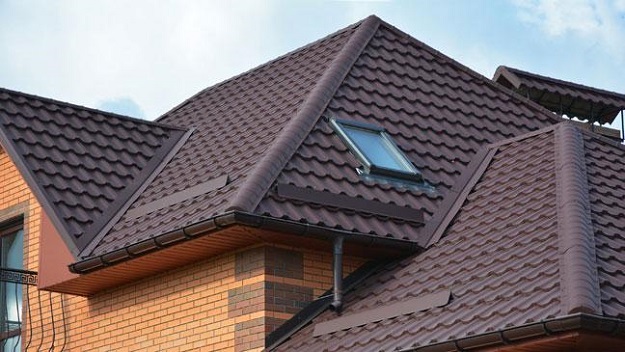Every homeowner knows the roof of their home is the most important structure of the building. Without a roof that performs well, moisture will enter the home and cause the supporting structure to fail. One of the most important decisions they are required to make is the type of roof that will best protect their investment. Considering the many choices of roofing material available today, choosing the right roof will require a good amount of research and acquiring of knowledge.
Asphalt shingles are used more often than any other residential roofing material in the United States. Asphalt shingles vary in quality and are produced by multiple manufacturers. The shingles are composed of two base materials with an asphalt base covered with granules of slate, quartz, stone, schist, vitrified brick or ceramic on the exposed surface. Talc, mica or fine sand is used to coat the underside so the shingles will not stick together before they are used.
Some asphalt shingles have copper or some type of biocide added to help prevent the growth of algae on shaded areas of the roof. Lighter colors are chosen most often in warm climates to reflect heat while darker shades are preferred in cool climates to absorb solar heat.
Wood shingles are tapered pieces of moisture resistant wood used mostly to protect roofs and sometimes walls from all kinds of weather. Originally, wood shingles to split using wood that was straight grained and knot free. Modern wood shingles are mostly cut rather than being split, unlike shakes that are split from a bolt of wood. Wooden shingles were used by early American colonists since there was a lot of natural wood available. Wood shingles are not very common today since homes with wood shingle roofs are more at risk for fire than other types of roofing materials. Since it is difficult to match the aesthetic appeal of wood shingles, some homeowners still choose this material even though their home insurance will likely be increased due to the increased risk.
Slate roofing tiles have some important advantages, but the most important to homeowners is likely the appearance. There is no other roofing material that offers a more aesthetic appeal, and slate is available in many beautiful colors including black, gray, red, green and purple. The tiles are also available in mottled shades with several colors included. Slate roofs hold the record for longevity with most lasting 150 years or more.
Don’t Miss –
The Ultimate Guide to Roofing Marketing
13 Sources for Awesome Website Inspiration for Your Roofing Company
Proper installation of a slate roof is essential to it lasting a lifetime. Only a roofing contractor familiar with the unique qualities of slate tiles should be hired to install this material on a roof. Because of its weight, the supporting structure of a slate roof must be able to support a slate roof or it will fail.
Slate is a naturally sourced material, so there are no environmental risks associated with its manufacture or disposal. Slate roofing is not only environmentally friendly, but it is also very fire resistant. A home protected by a slate roof will not be at risk from air borne cinders coming from adjacent house fires, forest fires or fireworks.
While one would think that roofing tile composed of stone would be very durable, slate is quite fragile and cannot stand up to someone walking across the roof once the tiles have been installed. Replacing broken tiles is difficult since finding the correct color match is very difficult.
Metal roofing has become increasingly popular over the past few decades, and there are some important advantages that homeowners should consider. Residential metal roofs do much more than just protect the home from rain, snow, sun and high winds. They are also energy-efficient, durable, fire resistant and beautiful with a wide variety of colors and styles from which to choose. The types of metal most often used to make metal roofing is aluminum, galvalume steel and galvanized steel.
Aluminum metal roofing has the advantage of being lightweight and virtually rust resistant. It is the best choice for coastal climates where moisture might cause other types of metal roofing to rust. Aluminum roofing is available in shingle, tile, standing seam, shake and slate profiles, so the homeowner is able to choose the look that works best with the design of their home. Aluminum roofing is also attractive to the environmentally conscious consumer since it is typically sourced from recycled material such as aluminum beverage cans.
Galvalume steel roofing is less expensive than aluminum, but it is stronger and corrosion resistant. Since it is less malleable than aluminum, it is not available in as many styles and weighs more than twice as much. This kind of metal roofing is primarily available in the standing seam profile since this style requires less bending. Some people prefer the shiny appearance of unpainted galvalume steel, but most choose to have it painted to provide better durability and to have their personal color choice.
Galvanized steel is used in roofing more than other kinds of metal because it is strong, does not cost as much as other types and is available in nearly any style. It weighs about the same as galvalume and is made of approximately 35 percent recycle materials. It does have disadvantages including a shorter lifespan, is prone to rust if not properly installed and maintained and is more difficult to install.
Armor Services says, the types of roofing materials and styles considered in this article are only the most commonly used choices. There are other kinds that offer various advantages and disadvantages for the discriminating homeowner. The cost of the roof and the length of time the homeowner expects to live in the house should also be taken into consideration before a final decision is made.

